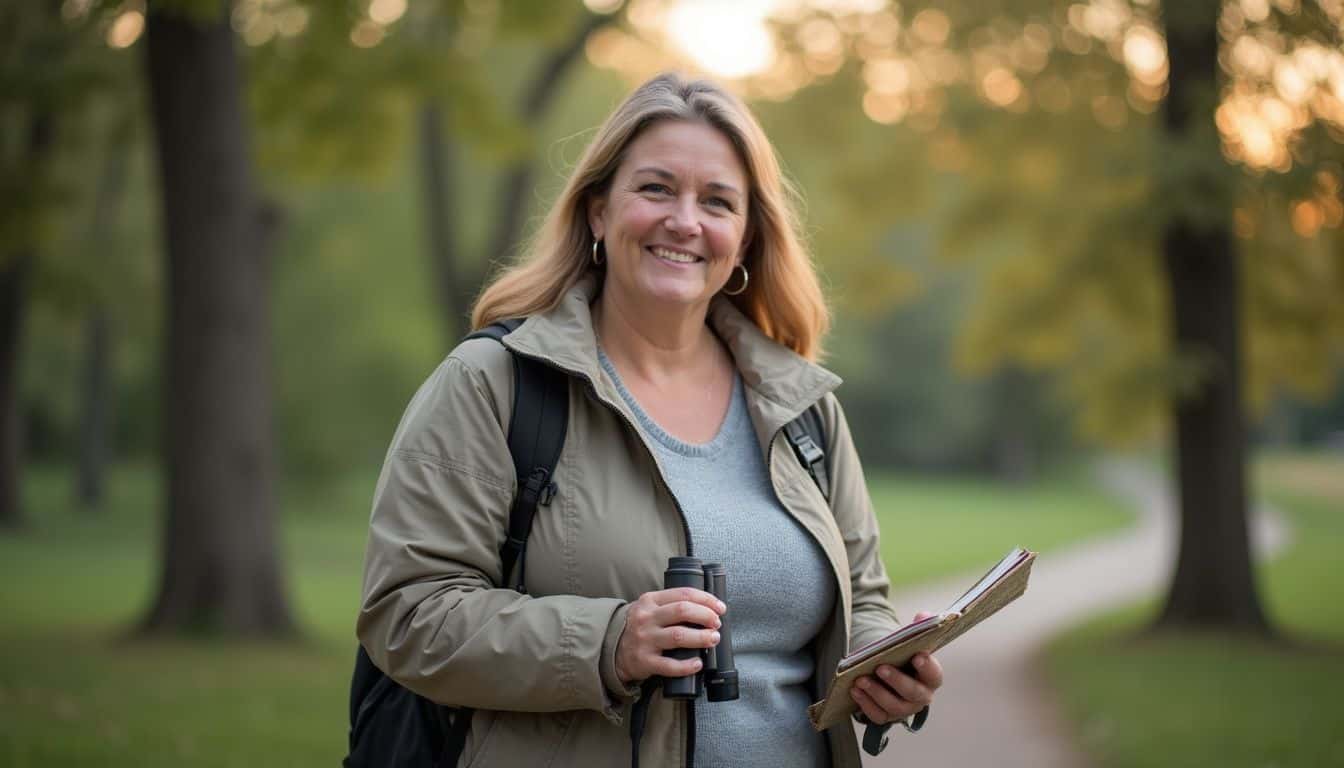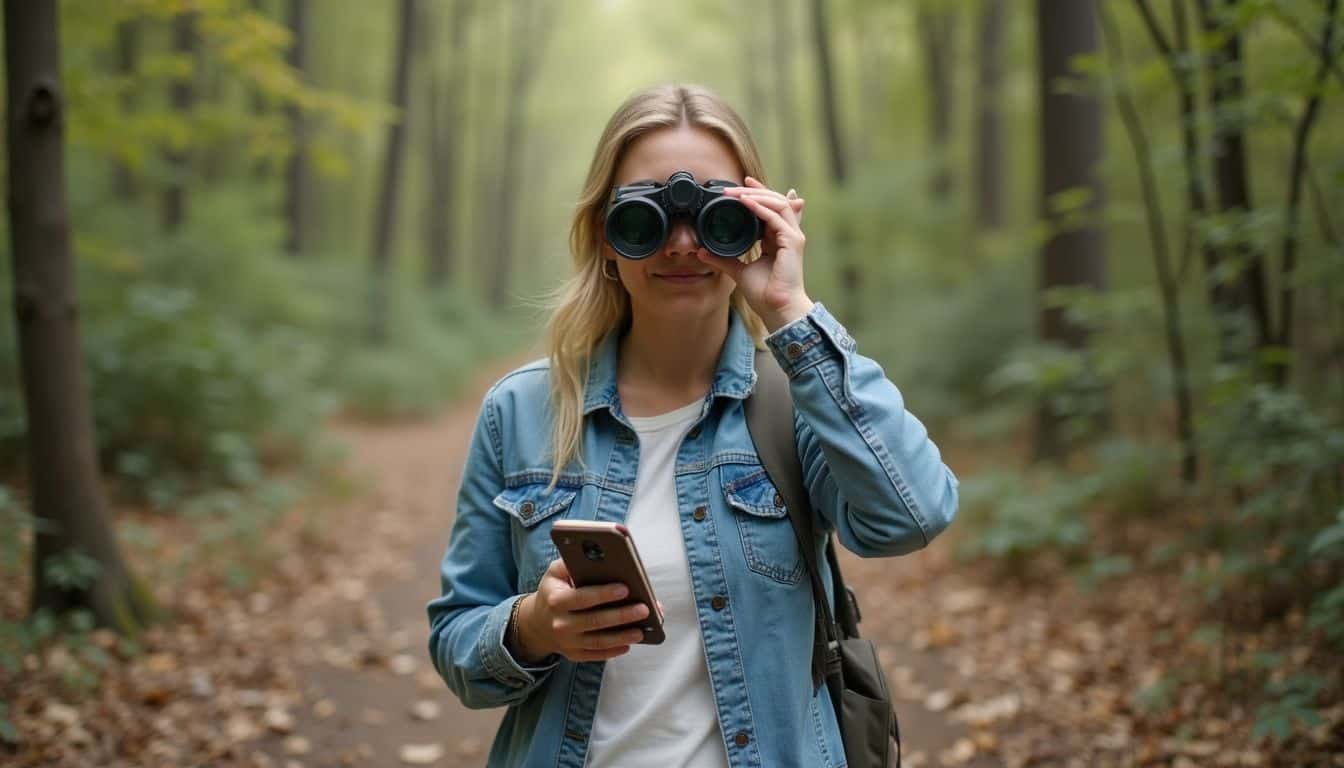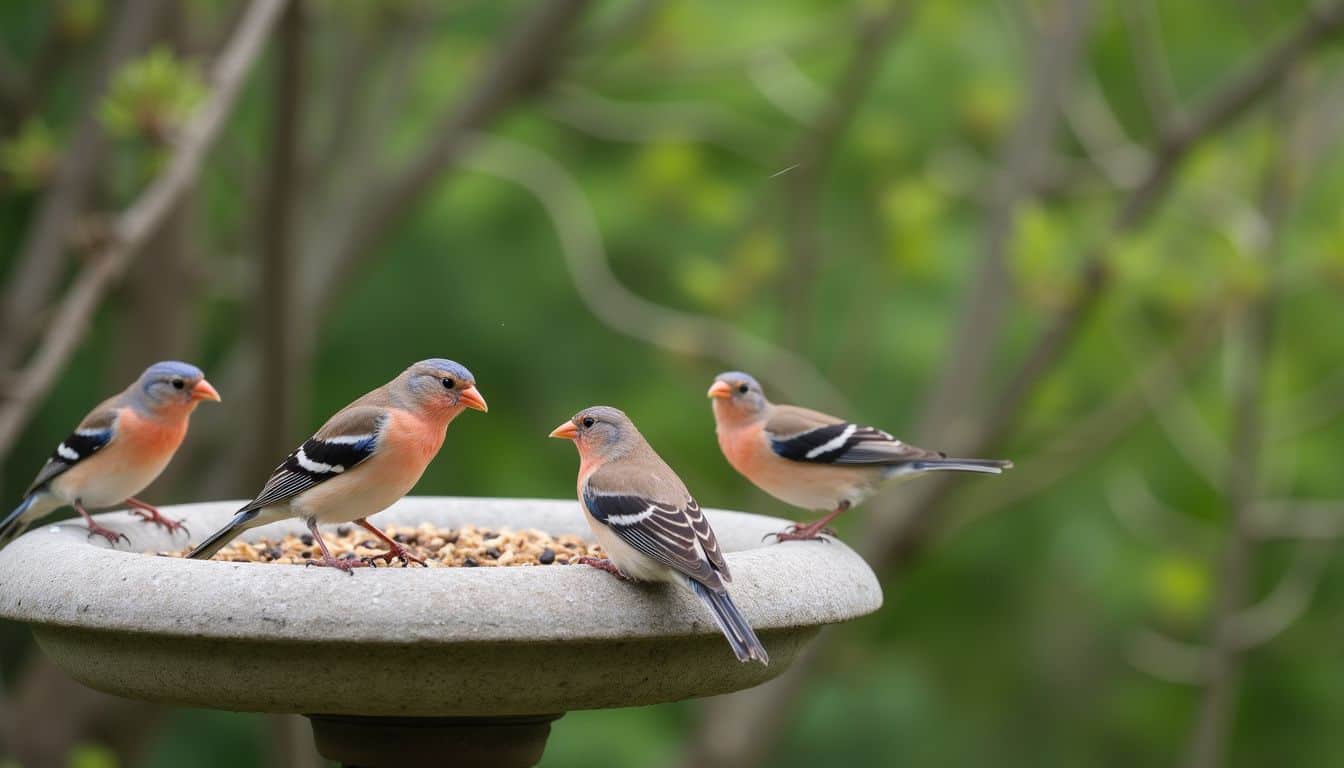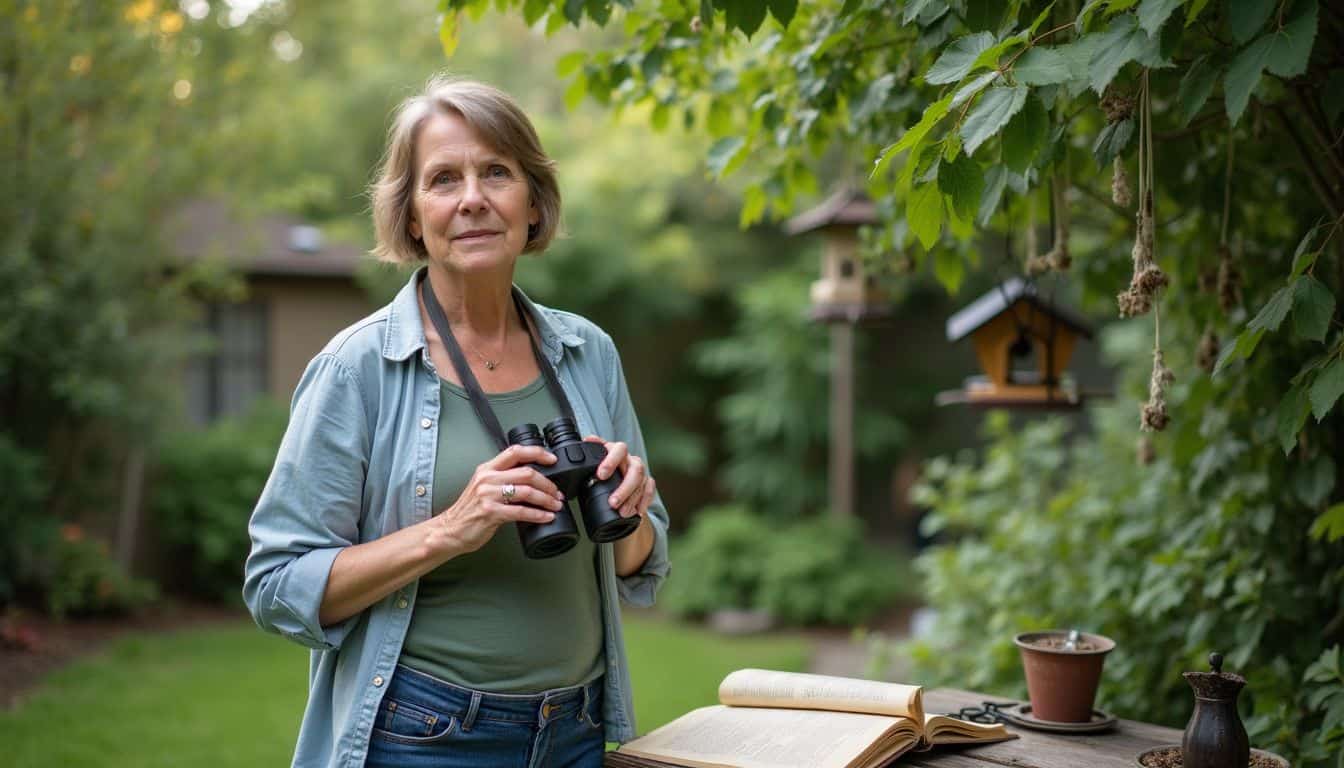Have you ever heard a bird singing outside your window and wondered what kind it was? If you’re curious about how to start birdwatching as a hobby but feel a little lost, you’re in the right place.
Bird watching is one of the easiest hobbies to pick up, and it helps you notice nature in new ways.
I’m going to walk you through everything you need to know, from choosing your first pair of binoculars to finding the best spots for backyard birding. Let’s get started together!
Key Takeaways
Getting into birdwatching is simple and affordable; a solid beginner pair of binoculars like the Celestron Nature DX 8×42 costs around $150, and powerful free apps like Merlin Bird ID can identify birds by sight and sound.
You can start in easily accessible places like local parks, city gardens, or wildlife refuges. Even urban spots like Brooklyn’s Prospect Park have recorded over 289 bird species.
Free apps like eBird and the Audubon Bird Guide are fantastic tools for beginners. They help you identify birds, keep track of your “life list,” and even show you maps of recent sightings in your area.
Birdwatching is a wonderful way to relax and relieve stress. A 2022 study from King’s College London found that seeing or hearing birds was linked to improved mental well-being for up to eight hours.
Always practice respectful birding etiquette by staying quiet, keeping your distance from nests, and following park rules. The American Birding Association provides a helpful Code of Ethics on its website.
Table of Contents
What is birdwatching and how is it done?

At its heart, birdwatching is like a treasure hunt where you get to spot birds in their natural homes. You tune your ears to different bird sounds and watch how various species go about their day.
To get a closer look, you’ll want a good pair of binoculars. Most bird watchers agree that 8x42mm or 10x42mm models are the sweet spot for beginners. The “8x” magnification is powerful enough to see details but steady enough to hold without much shaking, while the “42mm” lens lets in plenty of light for those prime birding hours at dawn and dusk.
Great beginner models, such as the Celestron Nature DX ED 8×42, are highly recommended and typically cost around $150 to $200. This small investment makes a huge difference in what you can see.
Many birders use field guides, either as books or through apps like eBird, to confidently handle bird identification. Early mornings are usually best since birds are most active then. Some people love keeping a “life list” on an app to track every new species they find, turning each outing into a fun challenge. Before you head out, you can check local resources to see what types of birds to look out for, or visit parks and wetlands where you might see common nightjars (chordeiles minor) or an American Oystercatcher (haematopus palliatus) during their migration patterns.
Soon enough, you’ll find yourself naturally listening for calls, scanning tree branches, and adding another feathered friend to your list each time you step outside.
Why should I start birdwatching as a hobby?

Birdwatching is a wonderful way to get outside, slow down, and connect with the world around you. You get to spot beautiful bird species, observe their unique behaviors, and appreciate wildlife right in their natural habitats.
How does birdwatching connect you with nature?
With every bird observation, you sink a little deeper into the natural world. Whether you’re on a trail in a national park or just sitting in your backyard, you’re pulled away from screens and into the moment.
With binoculars in hand, you might watch a woodpecker drumming on a tree or a flock of migrants soaring overhead. Every chirp and flash of color makes you more aware of the changing seasons. It’s a hobby that sharpens your mindfulness without you even trying.
Members of the American Birding Association often say their favorite part is simply slowing down enough to notice the tiny details, like a flicker of movement in a bush. Even a simple walk through a local wildlife refuge becomes more meaningful as you notice the small shifts that signal the rhythm of the environment. With each visit to places like the wetlands at Slimbridge or your local park, your ecological understanding and personal connection grow stronger.
To observe birds is to glimpse into nature’s soul.
How can birdwatching help with relaxation and stress relief?
Connecting with nature through birdwatching is a proven path to relaxation and stress relief. In fact, a 2022 study from King’s College London discovered that seeing or hearing birds improved participants’ mental well-being for up to eight hours afterward. This positive effect was even seen in people with depression.
The act of watching birds encourages mindfulness. Your brain focuses on the vibrant colors of a goldfinch or the funny way a robin hops across the lawn instead of on your worries. It pulls you away from the constant noise of notifications and social media.
Birdwatching can also help you feel more connected. The local birding community is full of friendly people who share a common interest, and you can join them for group walks or share sightings online. Spending just an hour watching a migratory warbler can lower stress, spark joy, and build a sense of peace.
What educational benefits does birdwatching offer?
Beyond its calming effects, birdwatching also gives your brain a workout. It helps sharpen your concentration and builds patience, especially if you keep a journal of your sightings.
You’ll quickly improve your observation skills as you learn to identify “field marks,” which are the key details that distinguish one bird from another. These can include things like the shape of a crest, the color of a wing bar, or the presence of a ring around the eye.
For kids and adults alike, this hobby can spark a passion for ornithology and bird conservation. You can even contribute to real scientific research through citizen science projects. Organizations like the Cornell Lab of Ornithology run programs like eBird and Project FeederWatch, which allow anyone to submit their sightings. Your notes from a park bench help scientists track migration patterns and understand how bird populations are changing.
Essential tools you need for birdwatching

A good pair of binoculars, a helpful birding app on your phone, and a simple notebook are all you need to turn an ordinary walk into an exciting birdwatching adventure. These tools truly make all the difference!
Why are binoculars important for birdwatching?
Binoculars are the key to unlocking the world of birdwatching. They bring distant birds into sharp focus, transforming tiny specks into creatures with vibrant colors and fascinating details. Even with a standard 8x or 10x magnification pair, you can see the fine red streaks on a Yellow Warbler (Dendroica petechia) or the delicate eye ring on a tiny wren.
A 42mm objective lens is ideal because it gathers enough light to give you a bright, clear view during early morning or sunset trips. Most modern binoculars use a “roof prism” design, which makes them compact, lightweight, and easy to carry on long walks.
While powerful spotting scopes are available, they require a tripod and are best for watching birds from a single spot, like at a coastal overlook. For everyday use, a quality pair of binoculars does more than just help you identify birds, it makes every bird observation feel like a real discovery and can even elevate your bird photography.
What are the best field guides or birding apps to use?
Once you have your binoculars, a good field guide or app is your next best friend. There are some fantastic digital options that are perfect for beginners.
Here’s a quick comparison of the top free apps:
| App Name | Key Feature | Best For |
|---|---|---|
| Merlin Bird ID | Sound ID and Photo ID | Quickly identifying a bird you see or hear right now. |
| Audubon Bird Guide App | In-depth information and range maps | Learning more about the birds you’ve identified. |
| eBird | Tracking lists and finding hotspots | Keeping a log of your sightings and finding new places to go. |
For those who prefer a physical book, the Sibley Birds 2nd Edition is a classic, though it costs about $20 as an app. It’s incredibly detailed, covering over 930 species. As one birder at my local club said, “Good field guides don’t collect dust, they collect memories.”
How can a notebook or birding journal enhance your experience?
A birding journal is a powerful tool for sharpening your skills and preserving your memories. By writing down the date, weather, and location for each bird you see, you’ll start to notice patterns, like when the robins return to your backyard each spring.
Some people love to sketch the birds they see, while others might add photos. I’ve found that using a durable, waterproof notebook like the Rite in the Rain Birder’s Journal is a great choice for field use. It keeps your notes safe no matter the weather!
Your observations also have real-world value. Organizations like eBird and Project FeederWatch use data submitted by hobbyists like you. By logging bird behavior and sightings, you become part of a global community of citizen scientists helping to protect birds. Each entry builds your confidence and creates a personal record of your birdwatching journey.
How do I get started with birdwatching?

It’s easier than you think! Just grab a pair of binoculars and your favorite bird identification app. Then, head outside and start paying attention to the birds that visit your backyard or local park.
What are the basics of bird identification?
Identifying birds gets much easier when you know what clues to look for. Experts at the Cornell Lab of Ornithology suggest focusing on four key things: Size & Shape, Color Pattern, Behavior, and Habitat.
- Size & Shape: Is it small like a sparrow or large like a crow? Does it have a long tail or a short, stubby one?
- Color Pattern: Look for distinct markings, like stripes on its head, bars on its wings, or a patch of color on its chest.
- Behavior: What is the bird doing? Is it hopping on the ground, climbing a tree trunk, or soaring high in the sky?
- Habitat: Where did you see the bird? Was it in a forest, a marsh, or your backyard?
Learning these field marks is the foundation of bird identification. As you practice, you’ll find that you can identify birds more quickly and confidently. Starting a life list in your journal or an app is a fun way to track your progress!
Birds are indicators of the environment; if they are in trouble, we know we’ll soon be in trouble.
Can I start birdwatching in my backyard or local park?
Absolutely! Many women discover the joy of birdwatching right at home or in a nearby park. You don’t need to travel to a remote wilderness area. Even bustling cities offer incredible birding opportunities, with New York’s Central Park and Prospect Park having recorded over 289 species combined.
You can start by simply watching with your naked eye. To attract more visitors, try putting up a bird feeder filled with black-oil sunflower seeds, which is a favorite for a wide range of birds like cardinals, finches, and chickadees. A birdbath also works wonders.
The best time for bird activity is usually early in the morning, but you can see birds all day long. The key is to be quiet and still. I once identified my first Downy Woodpecker while sipping coffee on my porch, and the excitement stayed with me all day. Backyard birding offers a wonderful sense of privacy and discovery, similar to the satisfaction of keeping chickens at home, but with a lot less work!
How do I research common birds in my area?
Getting to know your local birds is a great first step. A regional bird identification book or a field guide app like Merlin Bird ID can be incredibly helpful. These resources are often tailored to your state or area.
The eBird app has a fantastic “Explore” feature that shows you which birds have been recently sighted in your county or at specific hotspots. This is a great way to know what to look for before you even leave the house.
You can also visit the websites of national parks, wildlife refuges, or even your local park district, as many provide free checklists of common species. Don’t forget to look up your local Audubon society online; these clubs are treasure troves of local knowledge and are very welcoming to newcomers.
Best places to go birdwatching
Ready for an adventure? Grab your binoculars and head to the nearest green space. Birds are everywhere, from city parks and wetland retreats to botanical gardens, giving you a front-row seat to nature’s show.
Which local parks and nature reserves are good for birdwatching?
You’ll be amazed at the variety of birds you can find in parks and reserves, both large and small. While famous spots like Acadia National Park (261 species) and Everglades National Park (over 300 species) are incredible, you don’t have to travel far.
Many local parks offer fantastic birding. For example, Indiana Dunes National Park is a migration hotspot where 285 species have been seen. Even urban parks can be surprisingly rich in birdlife. Prospect Park in Brooklyn is a great example, with 289 different species recorded over the years.
A pro-tip for any visit is to stop by the visitor center first. They often have maps, recent sightings lists, and helpful guides to get you started. Using online tools like eBird’s Hotspot map can also help you discover amazing birding locations right in your own community.
What should I know about wildlife refuges for birdwatching?
After you’ve explored your local parks, visiting a national wildlife refuge can take your birdwatching to the next level. These areas are specifically managed to protect wildlife habitats, making them magnets for birds. The National Wildlife Refuge System, managed by the U.S. Fish and Wildlife Service, includes over 560 refuges across the country.
Many refuges, like the John Heinz National Wildlife Refuge near Philadelphia, are located along major migration routes. This means you can see incredible concentrations of songbirds, ducks, and other migratory birds during the spring and fall. I once saw a rare warbler at Prime Hook National Wildlife Refuge in Delaware, and it felt like winning the lottery!
Most refuges have observation platforms and auto-tour routes, which are perfect for beginners or anyone who prefers not to walk long distances. The staff also provides checklists of birds you’re likely to see, so you know what to look for.
Why are coastal or wetland areas ideal for birdwatching?
Coastal and wetland areas are simply buzzing with bird activity. These habitats provide the perfect combination of food, water, and shelter, which is why about half of all bird species in North America rely on them.
These spots are often situated along major migratory paths like the Mississippi and Atlantic Flyways, meaning over 340 types of birds use them as rest stops. I’ll never forget watching elegant Wood Ducks and vibrant Prothonotary Warblers in the same Michigan marsh.
The wide-open views make it easy to spot shorebirds, herons, and ducks. Thanks to conservation efforts by groups like Ducks Unlimited, many of these habitats are protected and thriving. If you want to see a lot of different birds in a short amount of time, a coastal trail or wetland refuge is the perfect place to go.
What are some helpful birdwatching tips for beginners?
Alright, let’s talk about a few simple tips that will make your first few outings even more enjoyable. Pack your binoculars, grab your guide, wear comfy shoes, and you’re almost ready to go!
Why is patience and observation important in birdwatching?
Patience is probably the most important skill in birdwatching. Nature moves at its own pace, and some days you might spend twenty minutes waiting for a single woodpecker to show itself. But that’s part of the fun!
Quiet observation helps you notice the small details that make each bird unique. You’ll start to recognize different feather patterns, body shapes, and the distinct call of a mockingbird. By sitting still and blending in, you allow birds to behave naturally, which can lead to incredible sights like courtship displays or territorial squabbles.
A great technique is to find a comfortable “sit spot” and just wait for 15-20 minutes. You’ll be amazed at how the world comes alive when you give it a chance to forget you’re there. Each quiet moment sharpens your skills and deepens your appreciation.
How can I learn to identify birds by their calls?
Learning bird songs and calls opens up a whole new dimension of birdwatching. The best time to practice is at dawn or dusk when birds are most vocal.
The easiest way to start is with an app like Merlin Bird ID. Its Sound Identification feature listens to the birds around you and shows you in real-time what they are. It feels like magic!
Another fun way to learn is by using mnemonics. These are little phrases that sound like a bird’s song. For example:
- The Carolina Wren sounds like it’s singing “teakettle, teakettle, teakettle!“
- The Eastern Towhee seems to say “drink your teeeea!“
As you listen, try to see the bird that’s singing. Connecting the sound with the sight is the best way to make it stick in your memory.
What should I wear to dress appropriately for birdwatching?
Your clothing can actually be a birdwatching tool. The goal is to blend into your surroundings so the birds aren’t spooked by your presence.
- Wear earth tones: Stick to colors like green, brown, gray, and khaki. Avoid bright white and vibrant colors.
- Dress in layers: A breathable shirt with a jacket or vest allows you to adapt to changing temperatures.
- Choose quiet fabrics: Avoid noisy materials like nylon that can rustle and scare birds away. Soft cotton or fleece is a better choice.
- Comfortable shoes are a must: You’ll likely be doing some walking, so wear supportive shoes. Waterproof hiking boots are great for muddy trails.
One important safety note: if you’re birding during hunting season, you must wear blaze orange to make sure you are visible to hunters.
Birdwatching etiquette to follow
Good manners are important, even in the wild! Following a few simple etiquette rules helps keep birds safe and makes the experience enjoyable for everyone.
How do I respect wildlife and their habitats while birdwatching?
The golden rule of birdwatching is to always put the welfare of the birds first. The American Birding Association has a helpful Code of Birding Ethics that provides great guidelines.
The most important thing is to keep a respectful distance, especially around nests. If a bird seems agitated or is constantly looking at you, you’re too close. Stick to marked trails to avoid damaging sensitive habitats where birds might feed or nest.
You should also avoid using playback devices that mimic bird songs, as this can cause stress and disrupt their natural behavior. At home, remember to clean your bird feeders weekly to prevent the spread of disease.
Why should I avoid loud noises and sudden movements?
This goes hand-in-hand with respecting their habitat. Birds are naturally cautious, and a loud noise or a sudden movement can easily startle them, causing them to fly away before you get a good look.
Think of yourself as a quiet visitor in their home. Move slowly and speak in a soft voice. By blending into the environment, you’ll see more birds acting naturally, which is far more rewarding. Patience and a calm presence are your best tools for getting close to wildlife.
What local guidelines and regulations should I follow?
Before you head out, it’s always a good idea to check the rules for the specific park or refuge you’re visiting. Most places post their guidelines on their website or at the trailhead. You can often find this information on the park’s page at nps.gov.
A few common rules to look for include:
- Staying on designated trails.
- Regulations against feeding wildlife.
- Seasonal closures of certain areas to protect nesting birds.
Following these rules helps protect the very birds we love to watch. It also ensures these beautiful places remain safe and accessible for everyone.
How can I join the birdwatching community?
One of the best parts of birdwatching is sharing the experience with others! The birding community is incredibly welcoming and full of people who are happy to share their knowledge.
How do I participate in local birding clubs?
Local birding clubs or Audubon chapters are the perfect place to start. Most clubs host monthly meetings and offer guided bird walks that are open to beginners. This is a fantastic way to learn from experienced birders and discover new local hotspots.
A quick online search for “Audubon society near me” is the easiest way to find your local chapter. Their websites usually have a calendar of events and information on how to join. Many also have active Facebook groups where you can connect with other members and share your latest sightings.
What birding events and workshops can I attend?
Beyond local club walks, there are all sorts of fun birding events you can attend. Many nature reserves and parks host guided hikes, workshops, and even big annual festivals.
Events like the Biggest Week in American Birding in Ohio or the Rio Grande Valley Birding Festival in Texas attract thousands of birders from all over the world. These festivals are a great place to learn, see amazing birds, and meet fellow enthusiasts.
You can also find beginner workshops that cover everything from using binoculars to identifying bird calls. These are often low-cost or free and provide a great foundation for your new hobby.
How can I connect with other birders online?
If you prefer to connect from home, the online birding world is vast and vibrant. Apps like eBird allow you to share your checklists and see what others are finding, while forums like BirdForum.net have active communities where you can ask questions and share photos.
There are also many social media groups dedicated to birding. For a particularly welcoming and inclusive space, check out the Feminist Bird Club, which has chapters across the country and is dedicated to creating a safe environment for women, BIPOC, and LGBTQIA+ birders. Their goal is to make the outdoors affirming for everyone.
How do I keep a birdwatching journal?
Keeping a journal is a wonderful way to document your birdwatching journey. You can use a simple notebook or a digital app like eBird. Watching your list of sightings grow over time is incredibly rewarding!
What bird species and locations should I record?
For each bird you see, try to jot down a few key details. This will help you remember the sighting and build your identification skills.
- Species: What kind of bird was it?
- Location: Be as specific as possible (e.g., “my backyard feeder,” “the pond at City Park”).
- Date and Time: This helps you track seasonal patterns.
- Habitat: Note if it was in a forest, wetland, or open field.
Keeping a “life list“—a running tally of every new species you’ve identified—is a fun tradition that almost every birder enjoys. It’s your personal record of all the amazing birds you’ve seen.
How do I note behaviors and unique observations?
This is where your journal really comes to life. Go beyond just listing the species and write down what the bird was doing.
- Was it singing from the top of a tree?
- Was it hunting for insects on the ground?
- Did you see it building a nest or feeding its young?
You can also make notes about its plumage, the sounds it made, or any interesting interactions it had with other birds. A quick sketch can also be a great way to capture a memorable detail, like the bright red crest of a cardinal.
Why is tracking progress over time important?
Tracking your sightings does more than just create a personal keepsake. It actively makes you a better birder. By reviewing your notes, you’ll start to recognize patterns in bird behavior and migration, sharpening your observation skills.
Your records also contribute to a bigger picture. When you log your sightings in eBird, you are contributing valuable data to citizen science. Researchers use this information to understand bird populations, identify conservation needs, and protect the habitats that birds depend on. Every entry you make, no matter how small, becomes a part of that important effort.
How will birdwatching change in 2025?
Birdwatching in 2025 is more accessible and high-tech than ever before. New features in field guide apps make it incredibly easy for anyone to get started. For example, the Sound ID feature in the Merlin app can identify a bird just from its song, and it’s constantly getting more accurate.
The hobby is also growing rapidly. A 2022 survey by the U.S. Fish and Wildlife Service found that over 96 million people in the U.S. participate in birdwatching. This growing community means more shared knowledge, more group events, and more voices advocating for bird conservation.
Technology is also changing the gear we use. While a great pair of binoculars is still essential, we’re seeing the emergence of “smart” binoculars. The Swarovski Optik AX Visio, for instance, has built-in artificial intelligence that can identify over 9,000 species of birds and wildlife for you. While they come with a hefty price tag of around $5,500, they offer a glimpse into the exciting future of the hobby. But you don’t need fancy gear to join in, the mix of simple tools and a lively, welcoming community makes birdwatching a perfect hobby for right now.
People Also Ask
What gear do I need to start birdwatching as a hobby?
You really only need a pair of 8×42 binoculars, which are great for beginners, and a helpful app like the Merlin Bird ID from the Cornell Lab of Ornithology to get started. A small notebook is also wonderful for jotting down what you see.
Where is the best place to spot birds for beginners?
Start right in your backyard or a local park, then use the free eBird website to discover nearby “hotspots” where other birders have reported sightings. Look for edge habitats, like where a field meets a forest, as these areas are often full of activity.
How do I identify birds if I am new to birdwatching?
Focus on the bird’s general size and shape first, then its main colors, and use a guide like the Sibley Guide to Birds or an app like Merlin Bird ID, which can even identify birds by their songs.
Can I birdwatch year-round, or is there a best season?
Every season offers something new, from nesting birds in the summer to dramatic migrations in the spring and fall, highlighted by events like the Global Big Day in May.
References
https://birda.org/how-to-start-birding-a-helpful-guide-for-birdwatching-beginners/ (2022-01-18)
https://whenonabreak.com/2020/11/08/10-steps-to-birdwatcher-hobby/
https://www.facebook.com/groups/179531089457/posts/10163202860919458/
https://www.facebook.com/groups/1680984025312005/posts/24631691233147959/
https://www.audubon.org/magazine/best-apps-birding-and-field-identification
https://betterwithbirds.com/blogs/backyard-birding/start-a-bird-journal (2025-03-18)
https://www.aarp.org/home-living/beginners-guide-to-bird-watching/ (2023-07-24)
https://birda.org/top-10-birdwatching-parks-us/
https://www.audubon.org/birding/how-to-start-birding
https://gl.audubon.org/news/wetlands-are-answer-better-birding-habitat (2019-05-13)
https://betterwithbirds.com/blogs/bird-identification/how-to-get-started-in-birdwatching (2025-03-18)
https://www.birdwatchingdaily.com/beginners/birding-faq/colors-not-to-wear-when-birding/ (2025-02-27)
https://www.feathersnapcam.com/blog/post/birding-etiquette-2025 (2025-03-18)
https://aswanbirdwatching.com/7-steps-to-start-birdwatching-a-beginners-guide/ (2025-07-30)
https://www.nps.gov/articles/birding-for-beginners.htm
https://bwdmagazine.com/tips-for-birders/getting-started/journal/
https://www.wingmate.au/blog/how-to-start-birding (2024-12-23)
